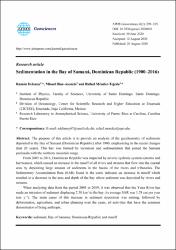/admin/item?itemID=503c779f-6c3f-4f9e-b56f-cffad081de21
Sedimentation in the Bay of Samaná, Dominican Republic (1900–2016)

View/
Type of Access
OpenMaterial Type
ArticleType of Content
Scientific researchLanguage
EnglishCollection
- Investigación ambiental [1743]
Metadata
Show full item record| Abstract: | The purpose of this article is to provide an analysis of the geochemistry of sediments deposited in the Bay of Samaná (Dominican Republic) after 1900, emphasizing in the recent changes (last 20 years). This bay was formed by tectonism and sedimentation that joined the Samaná peninsula with the northern mountain range. From 2003 to 2016, Dominican Republic was impacted by several cyclonic systems (storms and hurricanes), which caused an increase in the runoff of all rivers and streams that flow into the coastal area by depositing large amount of sediments in the basins of the rivers and tributaries. The Sedimentary Accumulation Rate (SAR) found in the cores indicates an increase in runoff which resulted in a decrease in the area and depth of the bay where sediment was deposited by rivers and streams. When analyzing data from the period 2003 to 2019, it was observed that the Yuna River has made an intrusion of sediment displacing 2.38 km2 to the bay, its average SAR was 1.78 cm per year (cm y-1). The main cause of this increase in sediment deposition was mining, followed by deforestation, agriculture, and urban planning over the years, all activities that have the common denominator of being anthropic. |
| Author(s): | Delanoy, Ramón
Díaz-Asencio, Misael Méndez-Tejeda, Rafael |
| Date: | 2020 |
| Published: | AIMS Geosciences, 6(3), 298-315 |
| Citation: | Delanoy, R., Díaz-Asencio, M., & Méndez-Tejeda, R. (2020). Sedimentation in the Bay of Samaná, Dominican Republic (1900–2016). AIMS Geosciences, 6(3), 298-315. Recuperado de: |
| URI: | https://bvearmb.do/handle/123456789/4992
|

